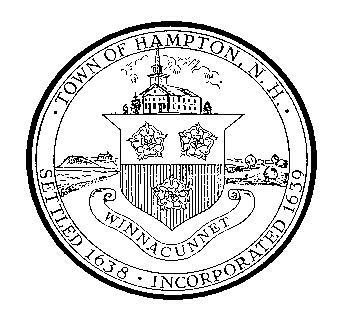From the 75th Anniversary edition
Hampton Union
July 23, 1975
Courtesy Tuck Memorial Museum

Designed & drawn by Hazle Leavitt Smith
1938
The seal of the Town of Hampton is on every Town Report, and is often seen by Hamptonites, but how many know its history?
In 1934 as a result of action by the General Court, New Hampshire's legislative body, all previous Town Charters were revoked, and new Charters were drawn by towns throughout the State with many communities adopting or re-adopting seals and flags. Hampton was about to celebrate its 300 year anniversary in 1938, and the Town Selectmen authorized a seal, which was designed and drawn by Hazle Leavitt Smith. A flag was also designed and used for many years.
The circular seal says: Town of Hampton, N.H. around the inside top, and around the inside bottom of the circle: Settled 1638,Incorporated 1639.
In the center of the circle is a shield with three rosettes. This shield with rosettes was taken from the seal of South Hampton, England and represents, for our Hampton, the fact that the early forebears came from South Hampton, England.
Resting on top of the shield is the Hampton Academy. The Hampton Academy School is in the seal to commemorate the fact that Hampton established a free school system only two years after the first public school was established in America. On March 21, 1649 John Legat was hired to teach "both male and female to read and write and cast accountes." Education played a large part in the life of Hampton’s early settlers.
To the left center is a representation of Great Boar’s Head, which is shown on many early maps of the coast. Opposite, on the other side of the shield, is shown the marsh and the haycocks with their supportive frames which were called staddles. The farming of hay on the marsh is Hampton’s oldest industry. The Hampton River winds through the marsh.
Below the shield, across the lower part of the seal is the word "Winnacunnet" on a scroll. The name Winnacunnet means "Beautiful Place of the Pines" and was the Indian name for the area encompassed by Hampton. The original name for Hampton was Winnacunnet Plantations.
At the suggestion of the Selectmen, the Tercentenary Committee ordered a flag from the Annin Flag Co. of New York City. A sketch of the flag, a description and color requirements were sent to the company. The seal designed by Hazle Leavitt Smith was to be used, the flag was to have an antique white background with a gold border and the design in royal blue and gold.
When the flag was received it was soon discovered nobody in New York City had ever seen a marsh with staddles and haycocks! The haycocks had become maple trees, the marsh had become a meadow and the Hampton River had become a winding country lane! Other than that, the design was in keeping ,with the Seal.
After the 300 year celebration the flag was turned over to the American Legion Post 35, to carry in parades and make available for Town functions and celebrations. The American Legion Post No. 35, Hampton, carried the flag in every Town parade from that time until 1961.
In the year 1959, while the "maple tree" flag was still in use, a committee was appointed by the American Legion Post to meet with the Selectmen to get permission for the Legion to obtain a new flag at their own expense to replace the original but unofficial flag, since the feeling prevailed that the "maple tree’ flag was too small and was not, after all, in keeping with the true idea of the design.
Roland Paige, Donald W. Harmon and Everett W. Mann were the committee and they contacted the Flag Shop in Amesbury, Mass., and the Flag Shop agreed to the task. By summer 1960 the Dettra Flag Company of Oaks, Penn., had completed the job and the flag was delivered to the American Legion. The flag cost $425. In July the flag was presented to a meeting of the Post.
The "staddle-haycock" flag was displayed at the Historical Meeting House museum in summer 1961 and was carried in Town parades for the first time that summer.
At the annual meeting of the "Meeting House Green Memorial and Historical Association" in November, 1964, Roland Paige presented a motion that the Society go on record as supporting and co-sponsoring with the American Legion Post No. 35 an Article for the Town Warrant (1965) to "...adopt the newly designed flat." The Society adopted the motion unanimously.
The flag is of light blue to represent the sea from which the settlers came. The center of the flag is the Town Seal adopted in 1938-1965.
